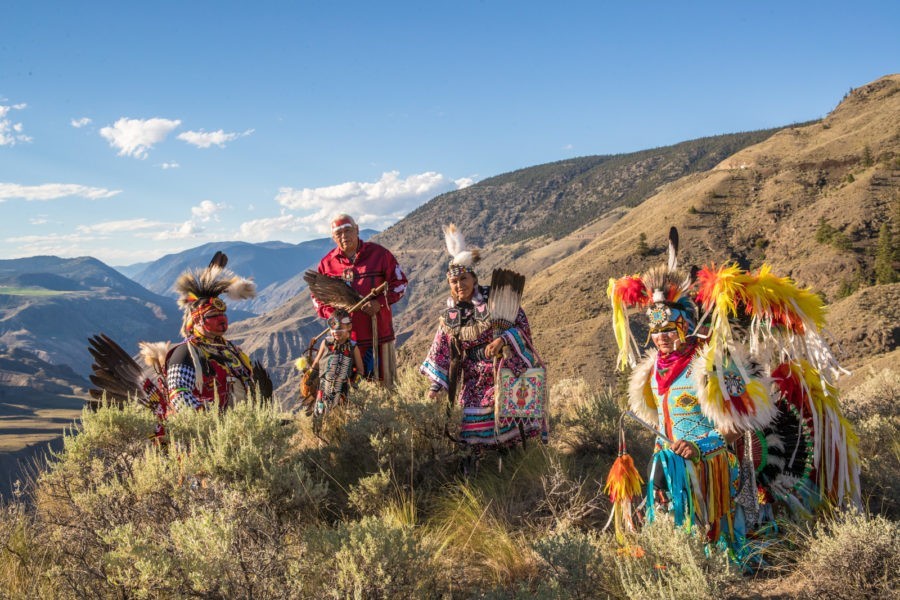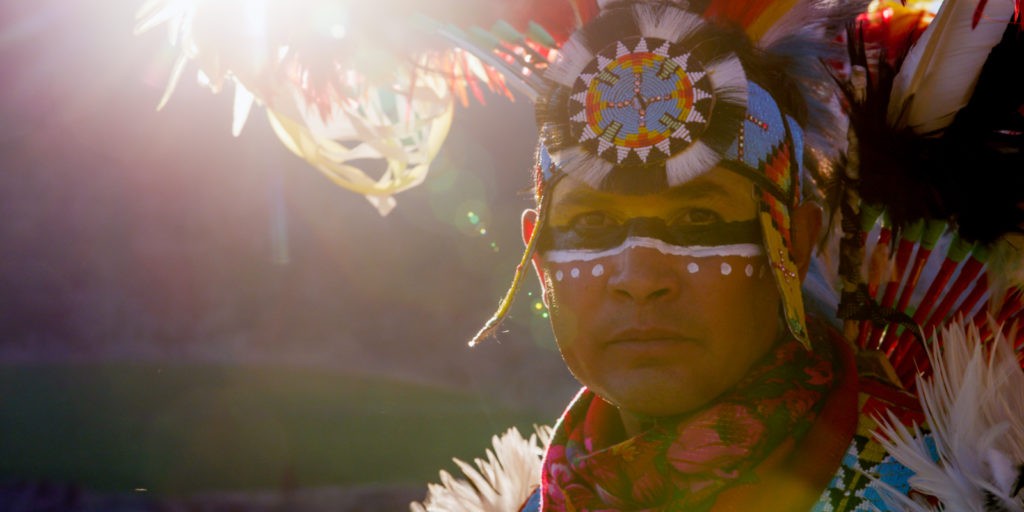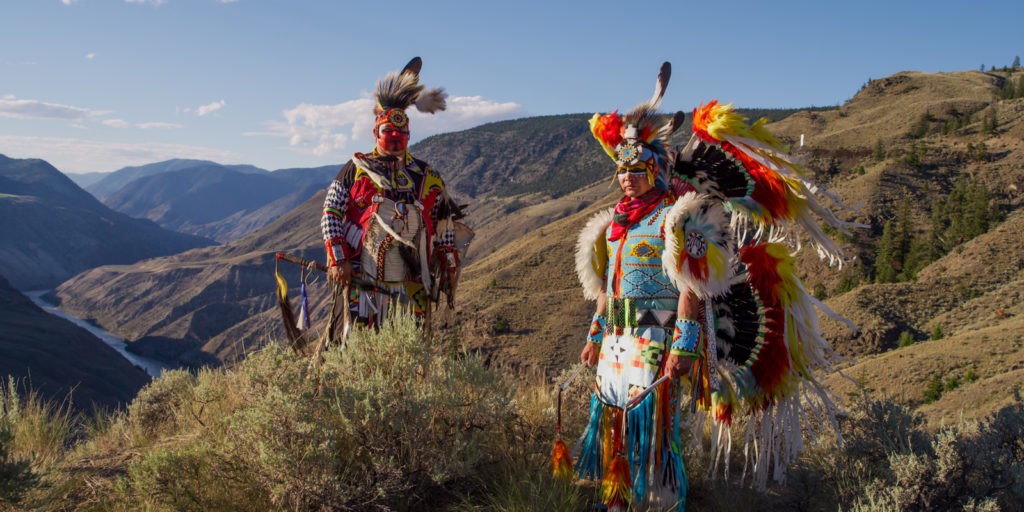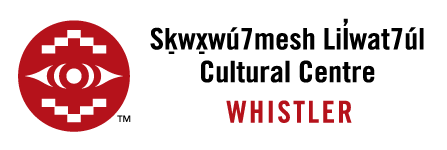
23 Jan Cultural Sharing at the First Nations Winter Feast
The First Nations Winter Feast provides a snap shot of Canada’s First Peoples. Guests often arrive eager to see Ambassadors in regalia, hear drumming, and taste cuisine that is authentically Indigenous. We also realize that guests are somewhat unsure of what to expect, though they are keen to learn more.
For most guests, there is an element of culture shock that announces itself upon arrival, and that’s what our team excels at delivering: powerful drums and vocals propel through the Great Hall before a guided tour takes guests on a deep dive into Squamish Nation and Lil’wat Nation knowledge. Afterwards, guests are led downstairs to the Istken Hall where they are seated and treated to a welcome by Daniel Wells, adorned in bold-coloured regalia that tells his story, powerfully quietening the room in preparation for a prayer before the Feast.
During the Feast, guests are told stories through song and dance while the Wells family wear regalia that dazzles their eyes. For their taste buds, guests savour a Salish-inspired menu that pays homage to Squamish Nation (Coast Salish) and Lil’wat Nation (Interior Salish) by incorporating food from the sea, land, and sky with modern ingredients.
What makes this evening truly unique is the breadth of culture that is shared. While culture shared during dinner is rooted in powwow, originating from the plains peoples, it has been adopted by both Squamish Nation and Lil’wat Nation for its powerful ability to bring together community in a substance-free environment (alcohol and drugs are strictly forbidden from powwow).
Squamish Nation hosted powwows for many years until 1958, when a thirty-year hiatus shelfed this community gathering. Upon resurrection in 1988, Squamish now hosts a powwow in July that brings hundreds of dancers and thousands of spectators together on their territory in North Vancouver. Attendees come from all across North America – some as far away as Florida.
In St’at’imc Nation (of which Lil’wat is a part of), powwows are hosted on New Year’s, Valentine’s Day, Victoria Day, and Thanksgiving. The first powwow in Lil’wat took place in c.1978 when a handful of families worked together to bring powwow to their community. One of the families involved since the beginning has been the Wells family, who are featured at our First Nations Winter Feast, and they sat down with us to share their personal journey and the positive contribution powwow has had to their Nation:

Alex Wells. Photo: Fast Fokus 
Daniel Wells. Photo: Fast Fokus
- How were you introduced to powwow?
Daniel Wells: my family had been dancing before I was born, I was destined to join them. My family is well known in BC for powwow – we connected with many families in the circuit we also did ceremony with Stony Nakota, Sioux [Ceremony: given the opportunity to bring songs and dances home with them]. Families seeking sobriety turned to powwow – the whole circuit doesn’t allow drugs or alcohol.
Alex Wells: Older guys were dancing at home; I was approximately five years old when I started. It began as a group of people in Mt. Currie practicing and learning all styles, every one of them with the same goal: to go on the powwow circuit.
- What First Nations territories have you travelled to in North America? How does it differ here vs. where you traveled?
D.W.: California, Georgia, New York… we travelled west to east. Each area has its own style of singing: the southern nations (Oregon, California, Arizona and Nevada) have a deeper tone when singing, compared to northern nations, which are higher toned.
A.W.: in one summer, we would go from here to Alberta (Dakota, Sioux, Blackfoot and Blood Nations), onto Saskatchewan (Cree), Wisconsin, Arizona, California, Florida, Texas, Oklahoma, and then home. It was three months of being on the road in a motorhome or station wagon and camping. We each had one suitcase full of regalia and clothes; there were five of us travelling together.
- What role does powwow play in the Lil’wat community?
D.W.: people really enjoy it. A lot of children dance; it makes people want to learn more about traditions – it has contributed to bringing back hand drumming & traditional songs.
A.W.: It is a gathering and time for celebration; connecting, catching up, and sharing stories.
- How was powwow introduced to Lil’wat? How was it received?
D.W.: a handful of families and family members travelled the powwow circuit and chose to bring a stop to Lil’wat. There were many dancers, and we [the Wells Family] have been a part of it since the first New Year’s powwow in 1978. As we got older, we became well known and earned the right to share songs and dances from other powwow families. In turn, we also shared Lil’wat dances on the circuit.
A.W.: very well; there are always new dancers and new interest in the community. We each try to inspire family support for each dancer, building greater community support. That way if any new dancers come up they will have that support.
- What nations do the songs shared at the First Nations Winter Feast originate from?
D.W.: We share Fawn Wood’s song, who is half St’at’imc and a well-known song composer and singer throughout North America; another is composed by Ted Napoleon who is also from the St’atimc Nation. We always make sure we explain where all the songs come from – it is one of our unspoken rules as singers.
A.W.: Different composers / older generations got to travel, singing and learning songs, eventually becoming composers. One song was made with my name to commemorate & honour while I’m still here (laughs).
Final Words:
Daniel: The Wells family is the prodigy of the older generation that brought powwow to St’atimc Nation. Ceremony, fasting, sweat lodge, and winter washes (breaking creeks to bathe in ice cold water) were all part of the discipline necessary to participate in powwow.
Alex: We’re here to share the culture. That’s what we’ve been raised to do.
Jenn: This is adopted culture that we enjoy and respect. It became a part of our own culture. That’s why you’ll see part of our own and some different because we’d like our guests to know we are not all the same, but we have the same respect for it all.
To learn more about powwow we recommend Kay Johnston & Gloria Nahanee’s Spirit of Powwow, available in our Gift Shop.



No Comments